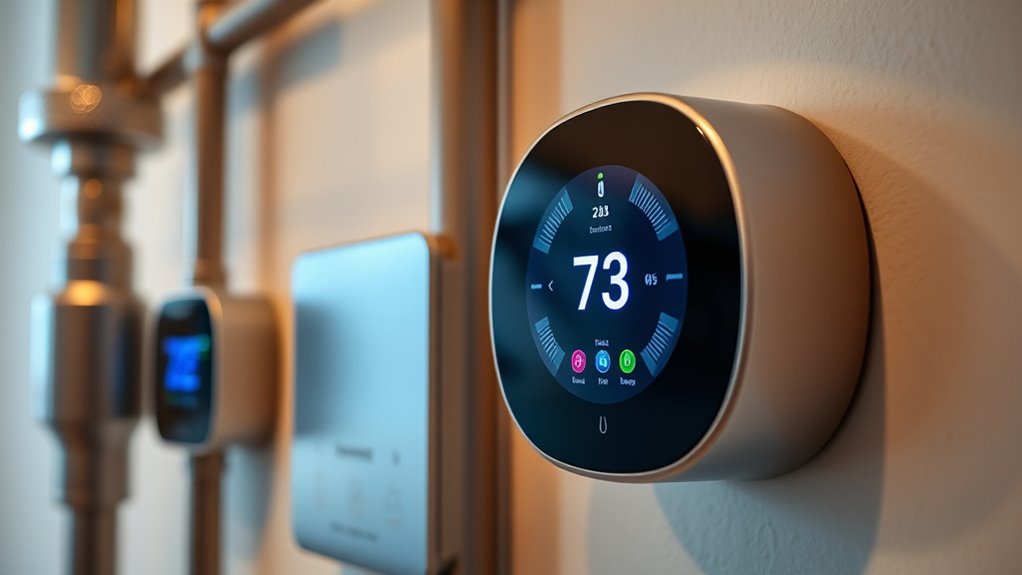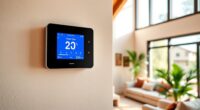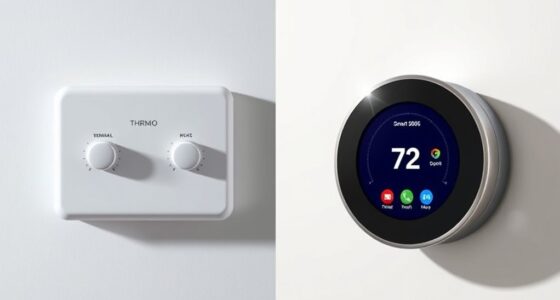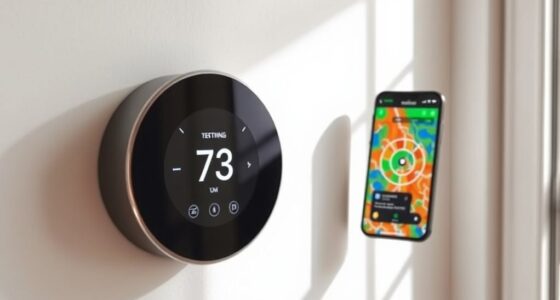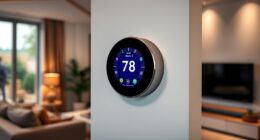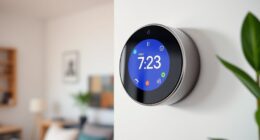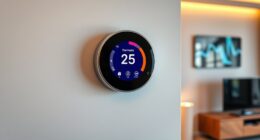When buying a smart thermostat for dual fuel systems, look for one that’s compatible with your existing setup and offers features like easy scheduling, geofencing, and real-time monitoring. A good device will optimize system performance by switching seamlessly between your heat pump and furnace, saving energy and reducing costs. These thermostats also provide detailed usage reports and remote control options. Keep exploring to discover how the right choice can boost your comfort and efficiency even further.
Key Takeaways
- Verify thermostat compatibility with your existing dual fuel heating system before purchase.
- Look for features like automatic switching, scheduling, geofencing, and real-time energy monitoring.
- Ensure the device supports seamless integration with home automation systems for enhanced control.
- Consider energy-saving capabilities that optimize heat pump and furnace operation for efficiency.
- Check for available rebates or incentives that can reduce overall costs of upgrading to a smart thermostat.
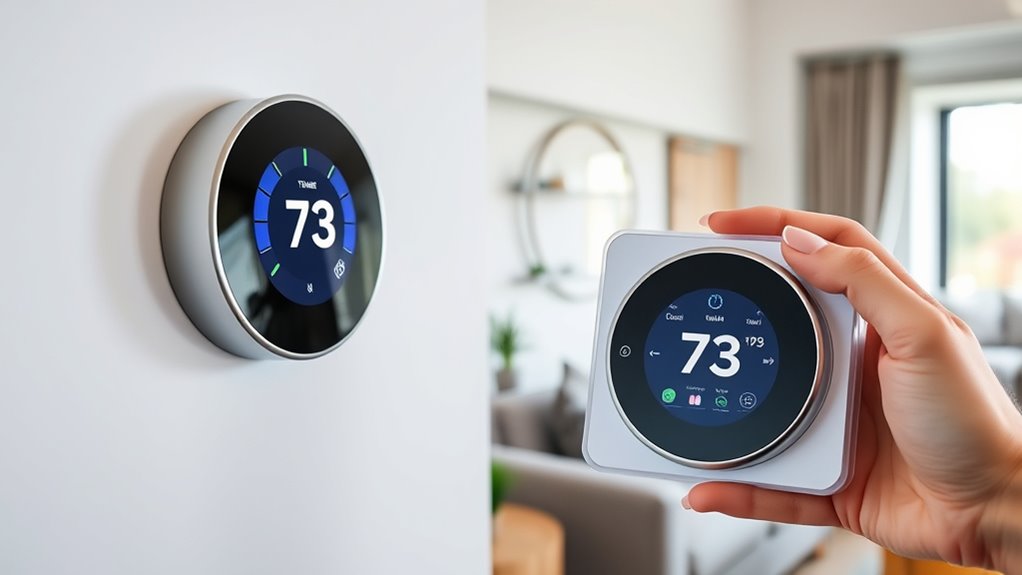
Choosing the right smart thermostat for a dual fuel system can considerably boost your home’s energy efficiency and comfort. When you select a thermostat designed specifically for dual fuel setups, you optimize how your heating and cooling systems work together, reducing unnecessary energy consumption. This means you’ll not only see a noticeable decrease in your energy bills but also enjoy a more consistent indoor temperature. A smart thermostat can learn your schedule, adjust settings automatically, and switch between your heat pump and traditional furnace seamlessly, ensuring you’re never wasting energy when you’re away or asleep.
Choosing a smart thermostat for dual fuel systems enhances efficiency, comfort, and energy savings seamlessly.
One key benefit of a well-chosen smart thermostat is its ability to enhance energy efficiency. By intelligently managing when and how your systems operate, it prevents your furnace or heat pump from running longer than necessary. For example, during milder weather, your thermostat can prioritize the heat pump, which is generally more energy-efficient, and only switch to your furnace when temperatures drop markedly. This dynamic approach maximizes the efficiency of your dual fuel system, helping you conserve energy and reduce environmental impact. Plus, many models come with detailed usage reports, so you can track how much energy you’re saving over time, giving you clear insights into your home’s efficiency.
Cost savings are another major advantage. When your smart thermostat optimizes your dual fuel system, you spend less on heating and cooling, especially during peak energy demand periods. The ability to program your system or rely on automation means you’re not paying for energy when you don’t need it—like during the night or when you’re at work. Many models also offer remote control via smartphone apps, so you can fine-tune your settings from anywhere, avoiding unnecessary energy use. Over time, these small adjustments add up to substantial savings, often offsetting the cost of the thermostat itself. Additionally, some energy providers offer rebates or incentives for installing advanced thermostats, further lowering your upfront expenses.
When choosing a smart thermostat for your dual fuel system, make sure it’s compatible with your existing equipment and supports features like easy scheduling, geofencing, and real-time energy monitoring. Look for models that integrate with your home automation system if you have one, to streamline control and maximize efficiency. Remember, investing in the right device isn’t just about modern technology; it’s about making smarter choices that benefit your wallet and the environment. With a well-selected smart thermostat, you gain better control over your home’s climate, enjoy more consistent comfort, and see tangible savings month after month.
Frequently Asked Questions
Can Smart Thermostats Improve Energy Efficiency in Dual Fuel Systems?
Yes, smart thermostats can improve energy efficiency in dual fuel systems by optimizing heating and cooling schedules, leading to significant energy savings. They adapt to your habits, ensuring you’re comfortable when needed and saving energy when you’re not. With remote control capabilities, you can fine-tune your system for user comfort while reducing waste. Overall, a smart thermostat helps you save money and enhances comfort effortlessly.
Are Any Smart Thermostats Incompatible With Specific Dual Fuel Setups?
Back in the day, you’d think all smart thermostats are universal, but compatibility issues can arise with dual fuel setups. Some models don’t support specific wiring requirements or control systems, making them incompatible. Always check the thermostat’s compatibility with your dual fuel system before buying. Verify wiring requirements and ensure the thermostat can handle your heating and cooling configurations to prevent future headaches.
How Do Smart Thermostats Handle Temperature Fluctuations in Dual Fuel Systems?
Smart thermostats handle temperature fluctuations in dual fuel systems by automatically adjusting settings based on real-time data, ensuring ideal comfort and efficiency. They often include humidity control features to maintain a consistent indoor environment. Plus, with voice integration, you can easily tweak temperature settings on the fly, helping you respond quickly to fluctuations and keep your home comfortable no matter what outside conditions are.
What Is the Typical Installation Process for a Smart Thermostat in Dual Fuel Systems?
Installing a smart thermostat in dual fuel systems is a breeze, and you’ll want to start by turning off power to avoid any shocks. You’ll connect it using wireless connectivity, ensuring seamless control, and double-check voltage compatibility to match your system’s requirements. Mount the device on the wall, follow the app’s setup instructions, and you’re all set to enjoy smarter, more efficient heating and cooling at your fingertips.
Do Smart Thermostats Require Professional Calibration for Dual Fuel Systems?
Smart thermostats typically don’t require professional calibration for dual fuel systems, but calibration requirements can vary based on the model and your system’s complexity. You should check compatibility considerations before installation to verify the thermostat works seamlessly with both your electric and fuel sources. Many smart thermostats offer user-friendly setup features, but if your system is complex, consulting a professional ensures accurate calibration and peak performance.
Conclusion
Choosing a smart thermostat for your dual fuel system might seem simple, but it’s about more than just technology. It’s about balancing comfort with efficiency, control with simplicity. You’ll enjoy seamless automation, yet stay connected and in charge. As you upgrade your system, remember that smarter choices lead to lower bills and a more comfortable home. It’s the perfect blend of innovation and practicality—making your everyday life easier and more energy-efficient.
